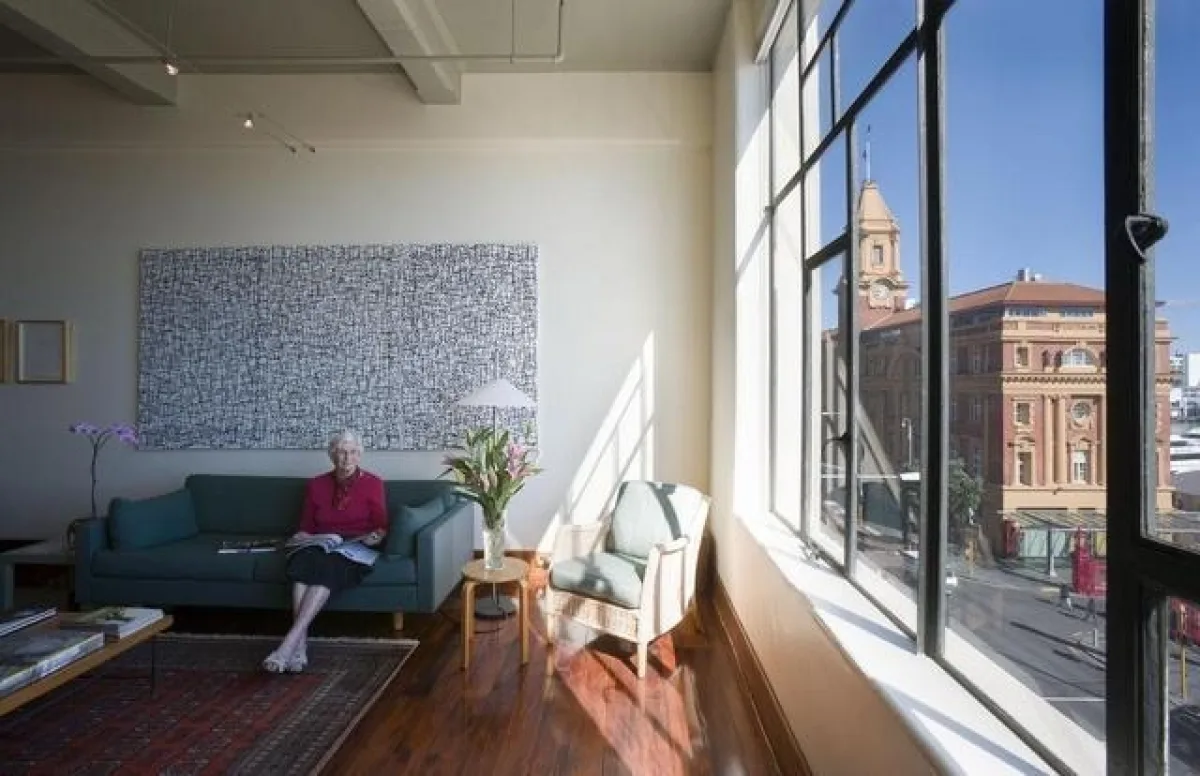Marilyn Reynolds in Conversation
11 Feb 2013Marilyn Hart was one of the founding members of The Group and one of the few female architectural students in the 1940s. There she met Ian Reynolds and the two married in London in 1949. After working in architecture firms both in London and Coventry, Ian and Marilyn Reynolds returned to New Zealand where they had six children. Her interest in architecture never dissipated and in the 1970s and 80s she authored key texts on the subject. In 1976 with Stephanie Bonny she wrote Woman's World: Houses and Suburbs, a defining work on the intersection of women and architecture. In 1980 she followed this with Living with 50 Architects, A New Zealand Perspective. In her work with the Society for Research on Women she also produced several research booklets on the housing of the elderly. Marilyn recently sat down with Nicole Stock from A+W, architect Jane Matthews and her daughter and architect/urban planner Amanda Reynolds to discuss her memories of study, working and women’s roles.

Nicole: How old were you when you went to London?
Marilyn: Ian got a what do you call it, a travelling scholarship, in the late forties. He went in ’48 or ’47…
Amanda: And you went in 49 at the tender age of 21.
MR: I don’t know, I was young anyway. But my parents let me go.
NS: And you weren’t married?
MR: Well, I was going to get married, that was the story anyway. Which I did. [When I got to London] I was so pleased to see him. Much as I read about London, when you get there, it’s bloody big.
AR: Yes, because pop wouldn’t let you get married before you went, did he?
MR: No, and you couldn’t live together either… in the ’40s you didn’t live with someone… or not in my family anyway, they would have cut me off without a shilling… not that they had a shilling anyway. He wanted me to finish architecture before I got married, he said: ‘You’ll lose your concentration’… all this sort of thing, and he was all quite right, but it just didn’t seem to suit our particular circumstances.
AR: We were talking about you working in London and Coventry… do you remember who you worked for in London?
MR: Yes, it was a street parallel to Oxford St… I can’t remember. And I got the job because one of the partners lived next door to us where we lived in Hampton Court, it wasn’t really going on the open market. Ian and I were just talking and saying well, ‘Marilyn must work now that we’ve settled down…’ and he said, ‘Well, we could do with another junior...’ or whatever they called us. And I thought that was fine, and went to work there. This was an Englishman. And apparently the wife had taken a liking to me. If someone likes you they will do anything for you.
NS: It doesn’t sound that different to how it is now. It’s all who you know, and if they like you. So, you hadn’t actually finished your architecture degree…
MR: Yes, I hadn’t actually been able to qualify, and of course my parents were furious with me. And I insisted on going to England and not finishing my degree. And they said, ‘You’ll never finish your degree, you’ll never go back to finish it…’ ‘Of course I will’, ha ha, what a joke it was… which of course I didn’t. But I got a job easily enough. There were plenty of jobs in London at the time after the war… but it was hard to get somewhere to live in London. There were many people who were happy to work in London, but they couldn’t find anywhere to live if they had a family. Ian and I were single…
NS: I would have thought in England that they would have been particularly worried about two people living together who weren’t married.
MR: They were more worried about peculiar people who were architects. Anyway I was no threat to them, but if you wanted to be an architect, that was a different matter… because there were quite a lot of architects without jobs at the time.
AR: Oh, I thought you said it was easy to get jobs..
MR: Well, it was different periods…
NS: So you were a draughtsman, or an architectural assistant…
MR: Yes, they called me an architectural assistant, in a small firm with three partners. And an office worker, and an apprentice, and we all worked in the one room. And I quite enjoyed it. And I did an awful lot of tracing, but they did listen to me when I said, ‘Well, what about changing this part of this plan’, and they might say, ‘Oh yes, that might work…’ They didn’t give me anything to plan as such, but if I had a reason to do things, they were quite agreeable, because they were young and they were making their way in the world too, and so there is some block of flats north of Tottenham court road, that’s got a Marilyn kitchen and bathroom… I hope they still work.
AR: Oh, I’m sure they’ve all been replaced three times by now, you know kitchens and bathrooms are…
MR: Because in those days the English were very much less kitchen and bathroom people than we were in New Zealand. Because you know, women worked in kitchens. And women are a lower grade of person, and as long as they gave them plenty of bench space and bought them a cooker, what more could they possibly want? And of course I made a big fuss about that, which perplexed them, but they let me do a few things. And I did a few schools. I worked on a few schools.
NS: Were there many women architectural assistants?
MR: No, we were a rare breed, and what’s more, we didn’t even talk to each other much. I’m ashamed of myself when I look back, I wasn’t the least bit friendly, they had a job and I had a job someplace else, and what was it to me? But there weren’t many of us.
NS: And you weren’t interested in networking and promoting women in the industry.
MR: Oh no, promoting ourselves and getting paid enough to eat… it was after the war, and professionals were paid a pittance… Ian was qualified and he earned a pittance, we could barely live on what he earned let alone the small amount they paid me. It changed quite quickly after we left… I don’t know what changed.
NS: Was that just because there was no money around, or was that just architecture?
MR: I think there was very little money around. Architecture in the UK was very different, it was all big firms who had named partners and they had sub partners, and people like me spinning around in the background. Very few sole practitioners, or even two together… and there was quite a lot of work but all the work went to who knew someone, if you went to school with someone… and you got a job, it was word of mouth. I used to say to Ian it was bloody unfair.
It was all so slow. That was the only thing that disappointed me about the UK. I mean, I hadn’t worked all that much in New Zealand, but things moved here. In the UK…
AR: What projects did you work on in London?
MR: Oh, I worked on schools. Schools were a big deal because the birth rate had gone boom. All those men had come back from the war and there were babies everywhere, so schools were a big deal. And I hated schools. There’s nothing more boring than designing schools. All those classrooms in a row, toilets, that’s all they are… or that’s all they were.
And turning rather nice 19th century houses into apartments. I suppose they’ve gone back to houses now… and I used to think what an awful thing to do, put a kitchen and bathroom on each floor, and make the staircase… urgh. Because Ian and I were really out of touch in a way. There was a lot of building but there wasn’t really much new modern design or anything. And what was done was done by the big firms, you couldn’t just set up practice over there unless you had a very big job, your aunt had money and wanted to build a factory or something.
But, it was fine, I didn’t really understand enough, what I was 20 or something. I didn’t understand how firms worked, about business. It took me quite a few years to work it out, that they got money, and they could employ more of us if they got more money. I was really rather dim.
AR: But when you went to Coventry, you worked at the council there?
MR: Yes, I worked for the council there, and that was much easier. Because the council got everything. They were red… very labour, very Do It. It wasn’t an old boys club. London was just a big old boys club. You know, the jobs went around. But Coventry was better, all the new towns wanted building quickly, and they mostly wanted apartments and houses. They wanted houses, really, but they were prepared to put up with apartments. So we did all these terraced houses. At one stage I refused to draw them anymore. Which didn’t get me anywhere, it actually made a great fuss in my group, and I didn’t get anywhere, and I had to climb down. But I said, ‘It’s silly putting these people with one baby in a two storey house.’
NS: What did you want to do with them?
I wanted something more social. Great arguments, where will they keep the pram… cause it couldn’t fit inside, inside the space was so damn tight that you could barely fit the baby inside let alone the pram. You know English prams… they’re huge. And of course, I was a bit too freely spoken, and I would say things like this, and of course the English architects were all drawn from the middle class. So they had mostly gone to private schools and they were used to women who were potentially ladies, and I was a bit common as far as they were concerned. I had a real trial with some people. Certain people… a principal would give me to a certain person to work under and quite suddenly I would be moved somewhere else, and it took me about a month to work out that the person I had been working for couldn’t stand me anymore. I was just too, too Red. Too commy. Too opinionated.
And of course they had all been through the architectural schools which were, at that stage very staid, very old fashioned because they hadn’t changed since before the war… and if you did anything different…
NS: Do you think New Zealand architectural schools were more forward thinking?
MR: Not particularly, I remember Vernon Brown standing there looking very severe, ‘We used to do that in 1938’. No, it wasn’t, we still had professor Knight when I was there, and then we got somebody else, but they weren’t very forward-thinking because the council of the university preferred to choose more experienced people. They didn’t want any of these young fly by nights.
NS: So The Group was very much a reaction against that.
MR: Oh people didn’t like us, even the students didn’t like us. ‘That awful Group.’
NS: So what were they teaching that you were rebelling against?
MR: It was mostly studio work, say the whole year was given a school to design and somebody did a two storey bit, and they would say, ‘We don’t do that sort of thing in New Zealand. All schools are one storey.’ And we said, ‘But these are secondary school children, they can climb up stairs.’ ‘At the moment, we are doing one storey, thank you… now go and sit down and shut up’ is what they said to me, practically. So, you know, I used to get in awful trouble because I wouldn’t always sit down and shut up, I would go and draw a two storey school, and I’d get fail. Which was silly. But there were all sorts of people who were very good like Bill Toomath who managed to go along with it without alienating the teachers. But I rather think the teachers thought the women were a damn nuisance, you know, full of commy ideas. The great threat in the world at the time was communist ideas, and if you had anything unusual, you had commy ideas.
NS: How many women were at the school?
MR: One year there were four. The year above me, there were two. Generally there were one or two, and there were generally 20 or 30 chaps, so we were very much the minority.
AR: That was very unusual that four…
MR: Oh yes, and we didn’t get on terribly well, either. Oh, it was difficult. Barbara was the next year up and she was terribly good, but the thing about Barbara was that she would draw and she could design, so she was very good, and the staff couldn’t fail her. But some of the other girls, who were entirely new to architecture did the most awful messes, even worse than me, and so they had to fail them, and they used to get upset. I remember one of the girls bursting into tears and the teacher walking out; he just couldn’t cope.
JM: Why did you decide to study architecture?
MR: Well, you tell me. I don’t know where it came from. I was always interested in building.
AR: [At school] The nuns, they got all these Architecture Reviews…
MR: Yes, someone had given them a subscription years ago, and when I saw them, I thought, ‘oh, how wonderful’.
AR: You would have been the only girl who ever read them. And she read the whole lot.
MR: I got a subscription for myself. I don’t think they thought it was a very good idea. They used to have little talks with my mother, and say, ‘Do you think it’s right that she considers this architecture business? We don’t think it’s a suitable career for a girl, you know.’
AR: Well, the nuns would know, wouldn’t they? The other thing is that there was only one architecture school and it was in Auckland, which was no where near your family.
MR: Which was a jolly good thing.
NS: So you had to move up to Auckland on your own?
MR: Oh no, I was carefully boarded with my grandparents who kindly let me do anything I liked. But I didn’t actually have any imagination. I went to the 5 o’clock pictures on Saturday and that was about it. The idea that 15-year-old girls when left alone would run wild is a real Victorian idea. I’ve never known any who have run wild.
[Architecture] was tricky, and no one understood. If you talked about it, no one could understand what you were talking about. With anyone really. The girls that were in the years, we got together but we weren’t terribly cooperative. I look back and think we could have formed a little pressure group if I had only thought of it. I hadn’t learnt about pressure, about society at that age. I was a bit innocent, really. I thought money came from parents, you went to school and university and then you got a job.
AR: But getting a job would have even been quite unusual.
MR: Well, my father got me my first job in the Ministry of Works, and I loved that, because in those days the Ministry of Works was so slack, so lazy. None of them did any work. And I was no different to anyone else. I quite liked the Ministry of Works. They were good because they knew who I was. I know that sounds terrible, but we were still living in a society then when it mattered what school you had been to and who your parents were, and so in Wellington, people knew who I was, knew who my father was, and that we lived in a mental hospital, which was a lot more interesting than doing architecture. Believe you me.
When I went to Auckland I had more trouble because no one knew where I came from, and I obviously couldn’t do anything, so what was I doing there?
AR: But you learnt to draw…
MR: Vernon Brown stood over me and said, ‘No, do that’. He was great. Even when we hated him, we loved him. He was a great big tall man. An Englishman who wore navy blue jackets. Having been in either the guards, or some sort of army thing. He would talk to me like a human being, which was nice, but some of them were pretty difficult.
NS: He was quite a supporter of The Group, wasn’t he?
MR: Oh yes…. But, even the ones who supported The Group, it was rather hidden support, they didn’t really shout it from the… because they had to get out and pass too, and some of the people who marked, they weren’t too fond of The Group.
We used to go down and have coffee at Summerville. And we used to waste a lot of time having coffee.
NS: This is probably a very personal question, but how did you put off having children while you were in London?
MR: We didn’t have any pills or anything. We had good old fashioned don’t do it, or a very inaccurate don’t get pregnant.
AR: But you went to Marie Stope’s clinic. You had a what… a cap.
MR: Yes, I had a cap. I hated putting it in. I don’t think it fitted me properly, and of course I didn’t have the confidence to go back and ask will you show me how to do this again, or get me a better one or something… but it wasn’t easy. And you couldn’t talk about it. Oh no, we didn’t in those days. It was do nothing, or avoid it.
NS: So why did you come back to New Zealand?
MR: My husband wanted to come back. I was the eldest of my family, and Ian was the youngest of his family, so his parents were very old. And my parents were saying, come back. Because in 1953 things were still rationed in England, at the time, if you can imagine. My parents kept saying come back, it can’t be good for you.
AR: And you’ve left out the crucial bit of information, you were pregnant.
MR: Oh yes. And the idea of having a baby in England rather appalled me. The architect’s wives had told me about waiting to have the baby and what happened when it does come, and I thought bugger, do they do that in New Zealand?
AR: And you couldn’t afford to live on one salary.
NS: Was Ian paid better in New Zealand
MR: Oh yes. And got more, how do you say, respect. They were so ignorant, you don’t know how… Things changes immensely in the 50s. All the old people in charge kicked the bucket, and a whole lot of new younger people came along who understood the new world. So Ian got quite a good job actually in Coventry. I got a job there too, for the council. Because he had a degree in planning. They were very impressed with planning. After the war they had a big thing of we must have more planning, there’s only architects and they don’t know anything about planning. And Ian had this planning degree, so he got pushed around to do things which was rather good. So I followed behind and got the draughtsman jobs.
NS: What did you do as a draughtsman?
MR: Lots of tracing. And then I would go to the head draughtsman and say, wouldn’t it be better if the kitchen sink was away from the front door and was over there. And he would look at me for a long time and he said, yes, you put it over there. But sometimes he didn’t, sometimes he said, go and sit down. But if you caught them at the right moment and it wasn’t too difficult they would let me have my way. These architects were all middle class families who had never even dried a dish, they had no idea what went on in a kitchen. I mean… they really didn’t want to know what went on in the kitchen as long as the food came. So they were very difficult. And I would say, you can’t have a kitchen like that because it’s miles from the sink to the cooker. I managed to get some books, one of those first books with the work triangle in it, and I remember using this book, and I said, look, this is what we do in New Zealand, and he was impressed. I mean, me talking was nothing, but it’s in a book. I had a lot to learn about how to manage men. By the time I stopped being an architect I knew what you do and what you don’t do to get what you want.
Although I left New Zealand and I assumed in England it would be much freer, it was no different. The men got all the jobs, and they handed it down to me at the end of the table. And I was never a particularly good draughtsman, which they told me at great length. And when I was about to leave one job, I said, well you’re not a particularly good planner, either. Dead silence. Don’t be impertenant.
AR: That was you learning to manage men?
MR: I think they were really shocked because no one had said anything like that to them before. And he thought he was very kind employing a silly woman and she could at least print the plans if she couldn’t do anything else, at least. I used to get all steamed up and then go all the way home on the bus, and poor Ian got an earful.
NS: What did Ian think about women in architecture?
MR: Well, fortunately, dear, he never told me.
NS: Once you had realised what working was like, would you have still chosen architecture?
MR: Oh yes, I really was interested in buildings. And by that time I knew quite a lot about buildings, what they were built of, but it took me a while, but I gradually learned what you had to know and what you had to say.
NS: All of that knowledge would have been interested when you started writing about architecture later.
MR: No, no one was interested, not the slightest bit interested.
AR: Well, a few of us were.
MR: Yes, well, a few younger women… but no one in power. If they hadn’t known it was written by me they may have taken more notice, but once they realised it was written by that damn difficult woman we employed one summer… they would say, ‘take it away!’












